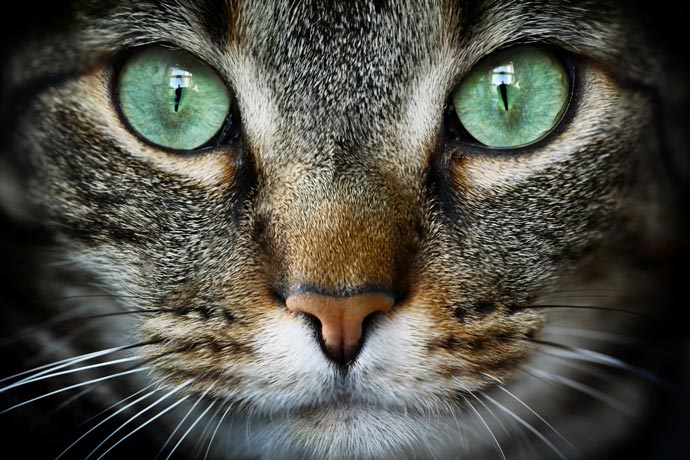Eye Problems in Cats: An Overview

There are lots of conditions that can negatively affect a cat's eyes. Whenever you see something different about your cat's eyes, it's crucial to get to the vet right away. Some things are easy to resolve, but as they worsen, it may become more difficult, and the kitty's vision could be compromised.
In the meantime, here are the most common eye conditions in cats, so you can keep an eye out for their signs.
Conjunctivitis
Conjunctivitis is inflammation of the conjunctiva, which is the soft tissue in the eyelids. Cats with conjunctivitis may appear to have swollen eyes. Redness is often evident around the edges of the eyelids, and discharge from the eyes could be clear, yellow, green, or white.
In cats, conjunctivitis can be caused by many conditions, including allergies, bacteria, and viruses. In kittens, herpesvirus (discussed below) is a big cause of conjunctivitis.
Uveitis
Uveitis is inflammation of the uvea, which is a combination of the iris, ciliary body, and choroid of the eye. It's a painful condition, and cats that have it may rub at their eye, squint, and present a red eye or eyes. The pressure inside the eye is too low.
Causes of uveitis in cats can include trauma to the eye, infections (especially FeLV, FIP, FIV, and toxoplasmosis), diabetes and other metabolic conditions, high blood pressure, and exposure to toxins.
Herpesvirus
Herpesvirus is a big cause of upper respiratory infections in cats. It spreads easily between cats. Infections are usually most severe in young kittens and cats with immune-compromising underlying conditions.
Among other signs of upper respiratory infection, like sneezing, herpesvirus often causes severe conjunctivitis. Kittens may have so much eye discharge that they're eyelids are "glued" shut. Some kittens with severe cases may have lifelong residual eye trouble.
Corneal Ulcers
A corneal ulcer is a scratch or perforation of the outer layer of the eye, the cornea. It causes redness, eye drainage, squinting, rubbing at the eye, and pain.
A cat may get a scratched eye from a foreign object, a fight with another cat, or from rubbing their eye too aggressively due to another condition.
Severe conjunctivitis from another cause can also damage the cornea and result in an ulcer.
Learn more: "Corneal Ulcers in Cats."
Melanoma
Melanoma is a type of cancer that arises in melanocytes, which are pigment cells. Because there are melanocytes in the iris and behind the retina, melanoma can occur in the eye.
Ocular melanoma (melanoma of the eye) in cats can present as diffuse dark areas visible in the eye or a raised, dark area around the edge of the eye.
Melanoma can cause uveitis or glaucoma and pain in the eye.
Hypertensive Retinopathy
High blood pressure in cats, which can be secondary to hyperthyroidism, kidney disease, or heart disease, can cause sudden blindness in cats due to the hypertension's effect on the retina.
The high blood pressure damages the delicate blood vessels of the retina and can eventually cause it to detach.
Glaucoma
Glaucoma is when there is increased pressure inside the eye. It causes pain and, eventually, blindness.
In cats, glaucoma can be caused by a malformation of the eye that doesn't allow proper drainage of the fluid inside it, but that's rare. It is most common in Siamese and Burmese cats.
Glaucoma can also be secondary to some other eye condition, like trauma or a tumor.
Glaucoma can cause the eye to look like it's bulging. It can also cause redness of the eye, wateriness, and the cat may rub at the eye.
Glaucoma is an emergency because there's extraordinarily little time to treat the eye and potentially save sight. That's why, whenever your cat's eye doesn't look right, you should call the vet right away.
Cataracts
Cataracts are opacities in the eye's lens. This can negatively impact the cat's ability to see, eventually even causing blindness in the eye.
Cataracts are rarer in cats than in dogs, but they can occur. Causes can include diabetes, inflammation, cancer, radiation exposure, and trauma to the eye.
Diagnosing Feline Eye Problems
When you take your cat to the veterinarian because you suspect an eye problem, the doctor will first take a history of the problem from you and look over your cat's chart to make sure he or she understands any concurrent medical conditions.
Next, your vet will do a complete physical exam, including taking a temperature, feeling lymph nodes, and looking into the eyes with an ophthalmoscope.
Next, the doctor may want to do some more specific tests to narrow down the problem. Some of these can include:
- Blood pressure check
- Blood work
- Staining the eye
- Checking pressure in the eye
Once your vet has narrowed down the diagnosis, treatment may include:
- Oral medication
- Topical eye medication
- Injections
- Other treatments as necessary for underlying conditions
For some conditions, your general vet may recommend a referral to a veterinary eye specialist.
You May Also Like These Articles:
FIP: Feline Infectious Peritonitis in Cats
Upper Respiratory Tract Conditions in Cats
Notice: Ask-a-Vet is an affiliated service for those who wish to speak with a veterinary professional about their pet's specific condition. Initially, a bot will ask questions to determine the general nature of your concern. Then, you will be transferred to a human. There is a charge for the service if you choose to connect to a veterinarian. Ask-a-Vet is not manned by the staff or owners of CatHealth.com, and the advice given should not delay or replace a visit to your veterinarian.






